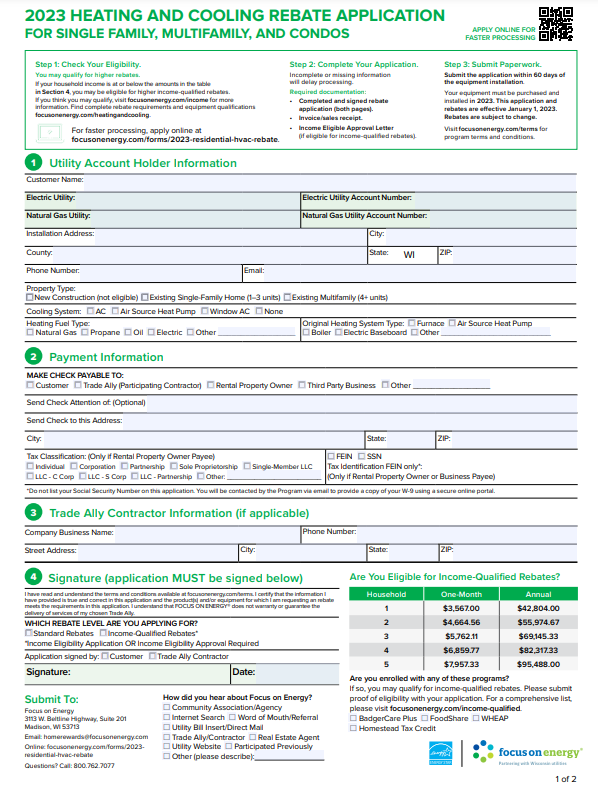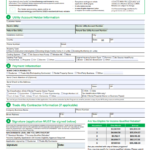Focus On Energy Rebate Form – Energy rebate programs have gained immense popularity in recent years as people become more aware of the importance of conserving energy and reducing their carbon footprint. These programs offer individuals and businesses an opportunity to save money while contributing to a greener and more sustainable future. In this article, we will delve into the world of energy rebate programs and focus on one crucial aspect – the energy rebate form.
What are Energy Rebate Programs?
Energy rebate programs are initiatives by government and utility companies to encourage energy efficiency and sustainability. They incentivize individuals and businesses to make energy-efficient upgrades to their properties, which, in turn, lead to cost savings and environmental benefits. Energy rebate programs typically come in the form of financial incentives, tax credits, or rebates.
The Benefits of Energy Rebate Programs
Saving on Energy Bills
One of the most significant advantages of participating in energy rebate programs is the potential for substantial savings on energy bills. By making energy-efficient improvements to your home or business, you can reduce your energy consumption and, consequently, lower your monthly energy expenses.
Promoting Energy Efficiency
Energy rebate programs play a crucial role in promoting energy efficiency. They encourage people to adopt greener technologies, such as LED lighting, Energy Star appliances, and high-efficiency HVAC systems. These upgrades not only save money but also reduce the overall demand for energy.
Reducing Carbon Footprint
Another substantial benefit of energy rebate programs is the positive impact they have on the environment. By making energy-efficient choices, you reduce your carbon footprint, contributing to a cleaner and healthier planet. This aligns with global efforts to combat climate change.
How to Qualify for Energy Rebates
Eligibility Criteria
Eligibility for energy rebate programs varies from one program to another. Typically, they are available to homeowners, renters, and businesses. Income limits may apply to some programs, while others may have no such restrictions.
Necessary Documentation
To apply for energy rebates, you will need to provide specific documentation. This may include proof of purchase for energy-efficient products, receipts, and sometimes even a home energy audit report.
The Application Process
Finding Rebate Programs
The first step in securing your energy rebate is to find suitable programs in your area. Government websites, local utility companies, and energy-efficient product retailers often provide information on available programs.
Filling Out the Rebate Form
Once you’ve identified a program that fits your needs, you will need to fill out the energy rebate form. This is a crucial step in the process, and attention to detail is essential to ensure a successful application.
Submitting the Application
After completing the form, submit your application as directed by the program guidelines. Many programs offer online submission options for convenience, while some may require mailing in your application.
Maximizing Your Rebates
To make the most of energy rebate programs, consider these additional steps:
Home Energy Audits
Before applying for rebates, consider having a home energy audit. This assessment identifies areas where you can improve energy efficiency, making your upgrades more effective.
Energy-Efficient Upgrades
Invest in energy-efficient upgrades, such as insulation, energy-efficient windows, and Energy Star-rated appliances. These investments will not only enhance your rebate eligibility but also provide long-term cost savings.
Tax Incentives
In addition to rebates, explore potential tax incentives related to energy-efficient upgrades. These incentives can further reduce your overall investment.
Energy Rebate Form: A Detailed Guide
What the Form Looks Like
Energy rebate forms may vary, but they generally require essential information such as your contact details, product information, and proof of purchase. Some programs may also ask for additional documentation like utility bills.
Sections and Fields
To avoid application delays, ensure you complete all sections of the form accurately. Be prepared to provide receipts, invoices, and any other required documentation.
Common Mistakes to Avoid
Common mistakes applicants should be aware of include failing to provide all required documentation, submitting incomplete forms, or overlooking important deadlines. Double-check your application to prevent these issues.
Conclusion
In conclusion, energy rebate programs offer a fantastic opportunity to save on energy bills, promote energy efficiency, and reduce your carbon footprint. By understanding the process of applying for rebates, you can maximize your savings while contributing to a more sustainable future.

